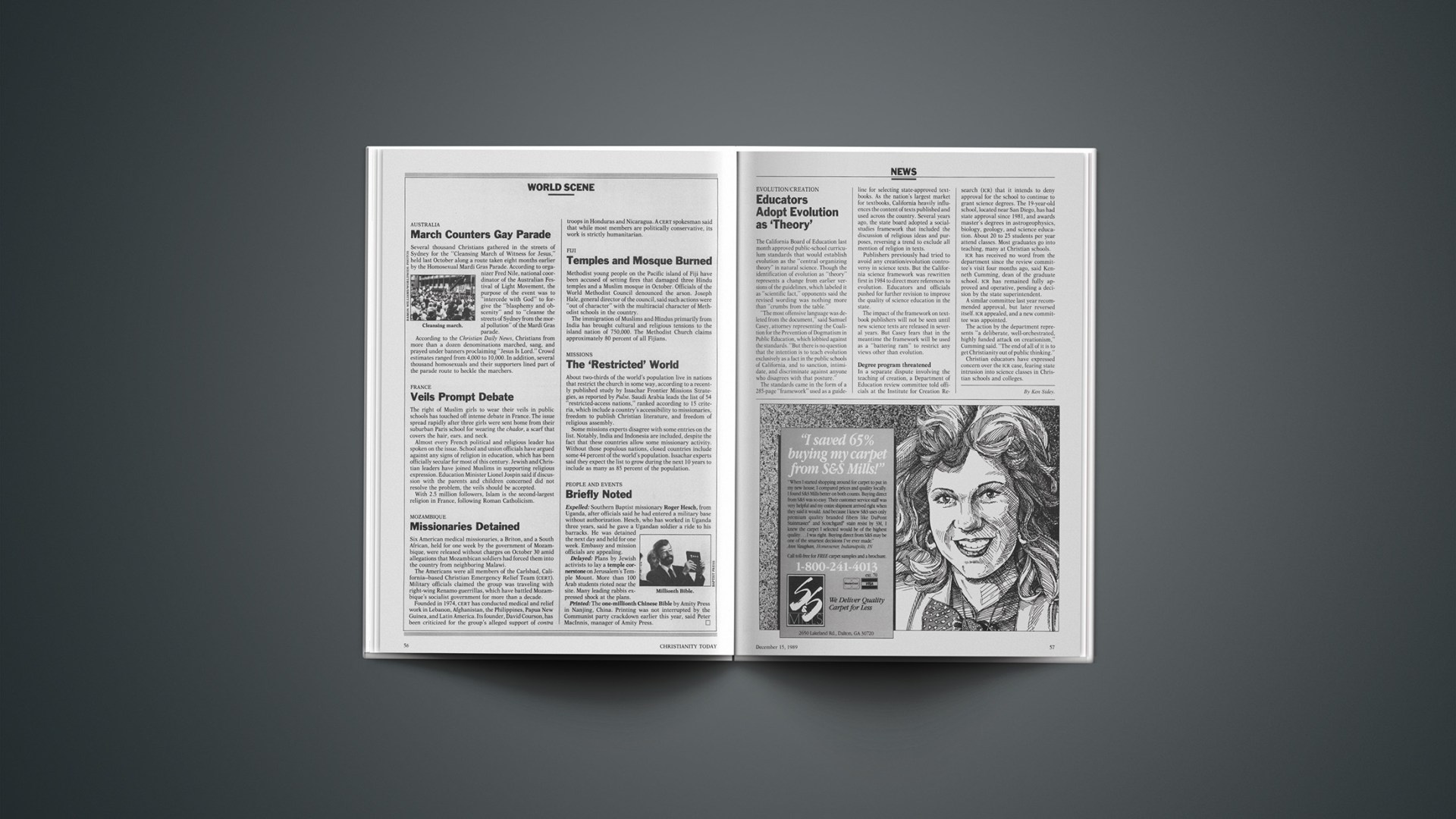Piercing the Darkness, by Frank Peretti (Crossway, 441 pp.; $9.95, paper). Reviewed by Michael G. Maudlin.
They’re back! Tal, the “golden haired” Captain of the Host; Guilo, the “dark-bearded” and “massive” warrior; and then there’s Armoth, the African; Mota, the mighty Polynesian; not to mention Signa, the Oriental, and Nathan, the Arabian. No, these are not Saturday morning’s latest collection of superheroes; this war band is made up of angels.
That’s right: angels.
The same battalion of God’s guerrillas that made the world safe for small-town Christians in the mega-selling This Present Darkness is up to its old tricks in this year’s sequel, Piercing the Darkness. Frank Peretti is not interested in providing a biblical exposition of angelology and demonology, however. Rather, he wants to give people a good read, and that’s what he does in his latest supernatural thriller.
As in their last outing, we find that the evil minions are picking on a group of simple, small-town Christians. And the minions are not just evil, they’re organized. The Satanists are in league with the local New Age group; both take orders from the Omega Center, a humanistic think tank that is secretly run by the Summit Institute, which controls lawyers, teachers, social workers, the media, the police, not to mention a Supreme Court justice. And if that’s not scary enough, there are also the demons: Despair, Lust, Hate, Murder, Greed, Deception, Rape, Divination, and on and on—all led by the yellow-eyed Strongman.
Their victim is Tom Harris, principal and teacher at Good Shepherd Academy, a small Christian school in Bacon’s Corner. He is accused of child abuse (spanking) and “outrageous religious behavior” (exorcism), based on the testimony of what turns out to be a demon-possessed little girl named Amber. Soon he is stripped of his responsibilities at the school; a social worker removes his children from his home; and he faces civil charges.
Talk about spiritual warfare! The action comes fast; the plot follows a roller-coaster path; and so the pages turn quickly—so quickly that it is easy to ignore some of the forced apologetics, stilted dialogue, and stereotyped characterization. All trappings of modernity—lawyers, social workers, psychologists, reporters, big-city bureaucracies, public schools, universities, and so on—tend to receive an evil cast.
And the theology is a little loose. At times it seems that human responsibility disappears—all evil is caused by demons and all good by angels. This is closer to primitive dualism than traditional Christian theism.
In other words, this book is entertaining but should not be read for its didactic value. A friend of mine heard a preacher say from his pulpit that Peretti’s novels are the best books ever written—after the Bible, of course. Peretti himself has said that his books are not blueprints for spiritual activity. In the tradition of Stephen King, Peretti has purposely altered reality to make the action a little more scary and exciting.
So while the novel may deliver spiritual encouragement or even spiritual insight, that does not necessarily mean that its picture of life on earth corresponds in all matters to reality. All demons are probably not winged, sulfursmelling beasties; neither is it likely that all angels are male, Nautiluspumping, Rambolike warriors.
CHRISTIANITY TODAY Talks to Frank Peretti
Frank Peretti is on a roll. His first novel, This Present Darkness, was the top-selling Christian paperback in 1988, even though it was released in 1986. And it has already sold more this year than last year. Since the August release of his second novel, over a million and half copies of that book have come off the presses. CHRISTIANITY TODAY caught up with the novelist in Atlanta and asked him about his “supernatural” fiction.
Are you surprised by the success of your books?
I can’t really comprehend it at all; I’m not going to try. I just want to do what the Lord wants, and I want him to be glorified by what I do. Apart from that, I don’t think about it much. It’s too dangerous to think about.
In Piercing the Darkness you describe a highly organized New Age/satanic conspiracy. How much of this is a literary device and how much do you think is descriptive of the way things really are?
Right now, it’s half and half—half fictional device, half reality. I think in a few years it will be more reality than it is fiction.
I think we’re heading for some real confrontation. Spiritual warfare is not a shooting gallery—the ducks shoot back. I think in the nineties we [North American Christians] are going to learn what the rest of the world already knows about the cost of discipleship. So, I think this is a pivotal point in history.
I noticed that in your book the angels are all male and take the appearance of different races. Why did you portray angels that way?
It’s a fictional device. I had one female angel in the previous book. Usually when they appear in the Bible, they have a masculine gender. As far as what their names are, that’s pure conjecture. The only names we know are Michael, Gabriel, and Lucifer.
What about the demons, who take on the names of vices and sins?
Demons will often take the name of whatever their role is, whatever sin or bondage they are performing. That’s backed up by Scripture where you have a spirit of infirmity, there’s a deaf-mute spirit, and various other spirits. They often go by the name of whatever it is they’re doing.
Some people are using your books as examples about the way things really are. How comfortable are you with that?
I’m not entirely comfortable with it because I don’t want people to forget that This Present Darkness and Piercing the Darkness are novels. They are fictional treatments of spiritual truth. They shouldn’t be treated as some kind of treatise on angelology or demonology. If they help you to get a better glimpse of how things work and inspire you to pray, and they help you to deal with the issues, that’s what they’re for. That’s good.
What is the most important thing you want readers to come away with from the book?
I want them to be reassured about the undefeatable redemptive power of the Cross. No matter how dark the darkness gets, no matter how bleak the situation may seem, you can’t stop the gospel. It’s never been stopped and never will be.
By Michael G. Maudlin.
In Search Of A Common-School Religion
The Myth of the Common School, by Charles Leslie Glenn, Jr. (University of Massachusetts Press, 369 pp.; $37.50, paper). Reviewed by Les L. Steele, associate professor of religion, Seattle Pacific University.
History has a way of helping us to release our strangle hold on the present and to bring perspective to emotion-filled issues. And that is what Charles Glenn accomplishes in The Myth of the Common School, which sheds historical light on such debates as the role of religion in public schools. Here Glenn traces the development of the idea of state-sponsored public education in France, the Netherlands, and Boston, Massachusetts, from the late 1700s through the 1860s. This is a massive undertaking. I will limit my comments to the early religious battles in American public education.
The early skirmishes over the proper role of religion in schools were not over secularism versus Christian theism. Rather, they were over “liberal” Christianity versus “orthodox” Protestantism. This battle was hard fought with such people as Charles Hodge of Princeton and Frederick Packard, president of the American Sunday School Union, arguing against Horace Mann.
Depending on your perspective, Mann was either the central hero or the villain who was primarily responsible for the development of what became known as the “common-school agenda.” This agenda, Glenn states, “is the deliberate effort to create in the entire youth of a nation common attitudes, loyalties, and values, and to do so under central direction by the state.” The goal was to “commonize,” or to create loyal citizens of the country.
This myth, supported by Mann’s evangelistic fervor, became the predominant ideal for American public education. It was not too difficult to Americanize most groups coming to Boston in the early 1800s, but the battle most vigorously fought was over religion. It was not, however, an attempt to exclude religion from the curriculum. The concern was to present a “sane” religion and to keep out the revivalistic or fanatical expressions that were a result of the evangelical awakenings that swept through the states at the time.
The common-school religion was to exclude the more “offensive doctrines,” such as human depravity. The common-school religion should affirm respect and love for God, love for all mankind, eagerness to be of service, modesty, humility, and so forth. Mann, of course, found his own Unitarian faith to be the right kind of religion. When accused of perpetuating his own faith, however, Mann’s response was that he was not proposing Unitarian faith but an “enlightened” Christianity.
It was the anti-Catholic concerns of both groups that eventually brought them together in an uneasy alliance in the 1850s. This was a period of intense Irish-Catholic immigration into Boston, and neither the “enlightened” Christians nor the “orthodox” Protestants cared for them. It was this extreme anti-Catholic spirit that led to the orthodox Protestant support for further limitation of religious content in schools. It is amazing to sense the extreme prejudice on the part of both the liberals and the orthodox. From this point on, religious instruction in the common schools declined to the point that it was virtually nonexistent by the time of the Civil War.
Eventually, the “myth of the common school” became a reality. From the early 1790s through the 1860s the curriculum was structured, the foundations for state control were laid, and the role of religion was reduced to no more than providing moralistic trivia. State control also entailed a minimum of parental choice in schooling, due mostly to the anti-Catholic concerns that eliminated the possibility of a system of schools with diverse religious perspectives supported by the state.
Glenn attempts to cover a lot of ground, and he is not always successful in all he wants to accomplish—although given the complexity of the issue this is understandable. Probably the most difficult aspect of the book is Glenn’s very appealing, yet possibly simplistic, solution to our continuing battle of religion and schooling. He is convinced that an extension of parental choice is needed in regard to “world view” options for schooling. He is attracted by the magnet-school model of desegregation as a possible approach to the religion problem. A pluralistic system of schools would be available, with state support, from which to select.
Needless to say, there are enough issues in Glenn’s book to create many a provocative conversation.
The Devil Takes Manhattan
The Fleetwood Correspondence, by William Griffin (Doubleday, 168 pp.; $15.95, hardcover). Reviewed by Robert Bittner, a free-lance writer living in Chicago.
When C. S. Lewis wrote The Screwtape Letters, little did he guess that his collection of letters from one fiend to another might become the most-read epistles outside of the New Testament. In The Fleetwood Correspondence, William Griffin (author of C. S. Lewis: A Dramatic Life) draws heavily on the Screwtape legacy, intentionally inviting comparison while presenting an Americanized, late-eighties update on the devilish ways of tempters today.
The target in this case is a young businesswoman new to New York City; the tempter is Fleetwood, a powerful demon who considers his uncle’s challenge to tempt one-on-one an insult to his intelligence. As the leader of a nationwide temptation conglomerate, Fleetwood is so pridefully certain of his skills that he refuses to work weekends.
Griffin’s strength is his diabolical sense of humor. “What the devil are you doing at Dimchurch?” Fleetwood writes his aging uncle. “I just found your address in the Directoire Internationale Diabolique, in the red pages no less!”
Lewis himself eschewed laugh-aloud humor, finding it incompatible with his view of hell. “Satan fell through force of gravity,” he once explained, quoting G. K. Chesterton. Lewis’s choice may have been the right one; Griffin’s fondness for exaggerated alliteration and Groucho Marx-line verbosity overshadows much of the book. The verbal free rein effectively weakens the kind of satirical probing and personal introspection that made Screwtape the classic it is.
The end of the story, however, is no laughing matter. Fleetwood, like his predecessor, Wormwood, eventually loses his prey to the “Supernal One.” It is Easter, and his young charge has decided there is no better time to publicly proclaim her faith in God. For Fleetwood, it is an embarrassing end to an experiment; for readers, it is a positive conclusion to an occasionally disappointing book.
Right-Brained Worship
People in the Presence of God: Models and Directions for Worship, by Barry Liesch (Zondervan, 352 pp.; $12.95, paper). Reviewed by Harry Boonstra, who is associate editor of Reformed Worship, and lives in Grand Rapids, Michigan.
In People in the Presence of God, Barry Liesch, associate professor of music at Biola University, delivers a solid, exciting book on worship. His prime audience is fundamentalists and evangelicals, who are heirs to the Puritan tradition of “spiritual” worship of simplicity and verbal expression. Although Liesch claims that an “unadorned, Puritan style of worship” may be just as “worthy” as the styles he describes in his book, much of the book is, in fact, an implicit (and at times explicit) criticism of the Puritan school of worship.
What alternatives does Liesch offer? The alternatives are derived from scriptural worship patterns, especially as found in temple and Revelation worship, as well as features borrowed from both charismatic and liturgical churches. For example, Liesch emphasizes the importance of the physical body in worship. We should not hesitate to kneel, clap, shout, or dance. Another emphasis is the use of all the arts, using the gamut of colors, shapes, and sounds. The visual, musical, and dramatic arts should be employed to the fullest. And we must be freer to be emotionally involved in worship. Evangelistic left-brain orientation has often produced cerebral, rigid, wordy worship. Liesch urges us to be more open.
The solid grounding of Liesch’s worship ideas in Scripture is commendable. And for Liesch the scriptural foundation is not a legalistic “regulative principle,” but a creative use of scriptural models. Other worthwhile points are his justified criticism of evangelical seminaries, which woefully neglect the teaching of worship; his examination of symbolism; the emphasis on worship versus performance; and the insistence that the congregation (not the preacher or the choir) should have a central role in worship. An additional bonus is the scattering of worship suggestions and resources.
As always, one is tempted to fault a book for what it fails to deal with. Perhaps such a critique is not fair, but I was disappointed in two major omissions. First, the sacraments are not sufficiently explored. It seems to me that part of the paucity of evangelical worship is the undervaluing of the sacraments. Liesch does not redress the imbalance. Baptism is hardly mentioned, and the Lord’s Supper remains a minor motif.
Second, I wish Liesch had paid some attention to church architecture. The monotonous parade of pseudocolonial evangelical churches and shoebox structures with little Styrofoam steeples demands scrutiny and new directions.
But the merits of this volume far outweigh the author’s slips. A fine book it is: worth reading, worth discussing, and especially worth putting into practice.










